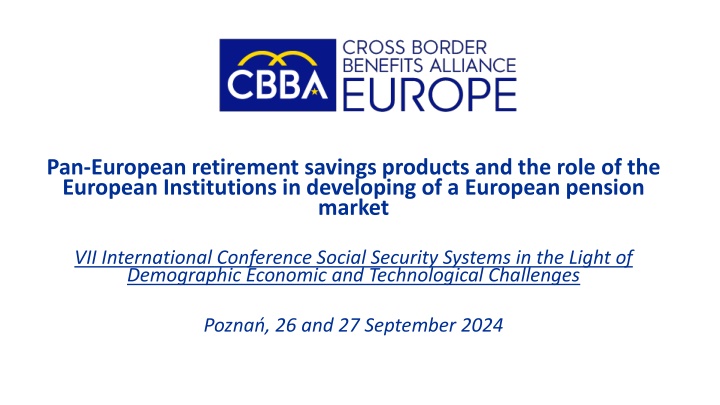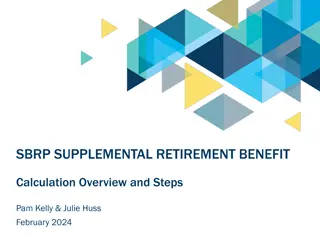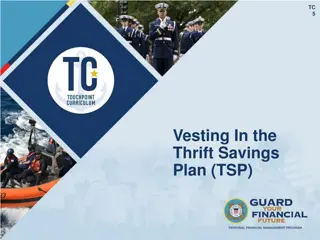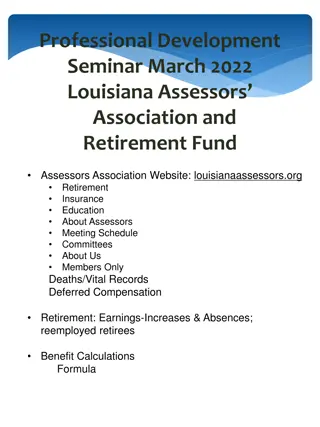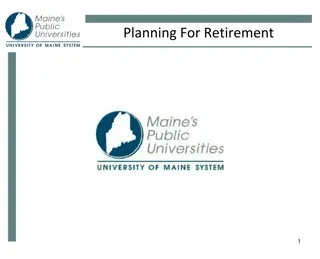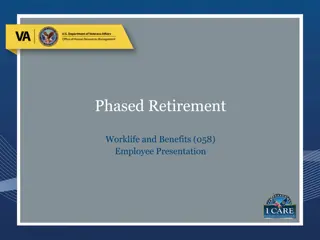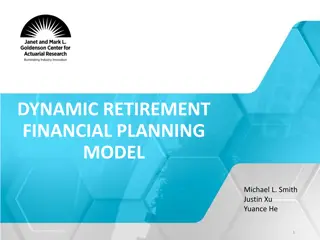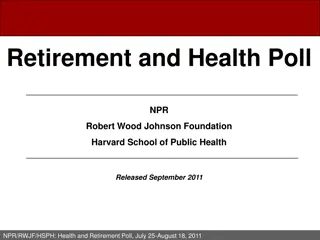Pan-European Retirement Savings Products and the Role of European Institutions in Developing a European Pension Market
This content delves into the landscape of Pan-European retirement savings products, focusing on existing cross-border and Pan-European pension tools in the EU, their features, regulatory frameworks, and the role of European Institutions in fostering a unified European pensions market. It analyzes the performance and popularity of such products, evaluates the challenges and opportunities faced, and proposes strategies for enhancing the development of a cohesive European pension market.
Download Presentation

Please find below an Image/Link to download the presentation.
The content on the website is provided AS IS for your information and personal use only. It may not be sold, licensed, or shared on other websites without obtaining consent from the author.If you encounter any issues during the download, it is possible that the publisher has removed the file from their server.
You are allowed to download the files provided on this website for personal or commercial use, subject to the condition that they are used lawfully. All files are the property of their respective owners.
The content on the website is provided AS IS for your information and personal use only. It may not be sold, licensed, or shared on other websites without obtaining consent from the author.
E N D
Presentation Transcript
Pan-European retirement savings products and the role of the European Institutions in developing of a European pension market VII International Conference Social Security Systems in the Light of Demographic Economic and Technological Challenges Pozna , 26 and 27 September 2024
Index: 1) Existing cross-border/Pan-European pension tools in the EU and their features 2) Some critical assessment on their popularity and performance 3) What could the European Institutions do in order to develop a real European pensions market? 4) Conclusions
1) Existing cross-border/Pan-European pension tools in the EU and their features
Cross-Border Pensions in Europe are currently regulated as follows: 1) Workplace/Occupational Pensions (IORPs) regulated by Directive (EU) 2016/2341 (IORP II Directive) 2) Pan-European Personal Pension Products (PEPPs) regulated by Regulation (EU) 2019/1238 (PEPP Regulation) While Workplace/Occupational Pensions (IORPs) are national pension vehicles allowed to carry out cross-border activities PEPPs are EU pension vehicles having features established by the European law, and hence acting (mainly) under the same conditions across the different EU member states;
The cross-border activities of pension funds (IORPs) according to the IORP II Directive
The cross-border activities of pension funds (IORPs) according to the IORP II Directive Cross-border activities of workplace/IORPs require the simultaneous compliance with at least 2 (or more) national legislations: - The national legislation of the pension fund (home state) and some of its features, including its prudential regulation; - And the social and labour law (and taxation rules) of the state where the pension fund (IORP) will offer its services, as to say the legislation of the state where the employer (company) and its employees are located. Example: A company Alpha (employer) from the State B decides to offer an occupational retirement plan to its employees (also located in the State B ). In order to do so, the company Alpha decides to join, or to set up, a pension fund Beta located in the State A. Social, labor and tax laws will be the ones of the State B, where Alpha and its employees are based; Prudential rules will be the ones of the State A, where the pension fund Beta is located)
The cross-border activities of pension funds (IORPs) according to the IORP II Directive Home state: where the pension fund is based; Host state: where the sponsor company (employer) and employees are based. The pension plan (or scheme; or arrangement) is designed according to the local rules of the host state. Compertamentalised (Country by Country local arrangements) Example: Home state A is Belgium; Host States B , C , D , E are: Germany, Italy, Ireland Poland, etc.
The Pan-European Personal Pension Product (PEPP) and its features
The Pan-European Personal Pension Product (PEPP) and its features -Main idea: a personal pension provider based in a Country A , might offer its product all over Europe .to clients based in Countries B , C , D , etc.. (EU passport) -Once a client/user of the PEPP Alpha moves to another Country, he/she will be covered by the local branch (sub- account) of PEPP Alpha in the new Country of destination -IMPORTANT: the PEPP Regulation is a 2ndor 28thEU legal regime (voluntary, alternative. This means that the rules on PEPPs will be not applicable to the national pension products, which will continue to follow their national rules)
PEPP: Main features -Possible providers of PEPP (insurers, asset managers, banks, and IORPs: IORPs allowed offering PEPPs only according to national implementation); -Portability (minimum 2 national sub-accounts must be created: no issues with national authorizations) and transferability of capitals between different PEPPs (when user changes PEPP provider); -6 investment options, 1 of which is, for the Basic PEPP is the standard and should guarantee (insured), or protect, the capital invested (lifecycle option); -Strict rules and framework on risk mitigation techniques (not only for basic PEPP); -Maximum administration costs threshold of 1% for basic PEPP, including a mandatory advice for new users; -Strict rules about distribution of PEPPs; -Strict requirements about information to users; -Coverage of biometric risks, pay-out methods, decumulation, (up to PEPP providers to decide/national legislation);
PEPP: And what about taxation? -Recommendation of European Commission on the tax treatment of personal pension products, including the pan-European Personal Pension Product (Doc n. 4393 of 29.6.2017) -Basically, taxation on pensions remains a national responsibility; the European Commission tried to assure that the same (advantageous) tax treatment for national personal pension products is the same for PEPPs operating in EU member states Even if the PEPP does not exactly/totally correspond to the features of the national pension products; - Recommendation. In some Countries, PEPP are fiscally less advantageous than national personal pensions. Not all member states followed the Commission s
2) Some critical assessment on popularity and performance of cross-border/Pan-European pensions
Cross-border activities of pension funds (IORPs) as provided by the IORP II Directive did not achieve enough success Main obstacles to cross-border activities of pension funds as provided by IORP 2 Directive: A) Difficulties to obtain the authorizations from the National Competent Authorities (NCAs), mainly from the host-state ones. Spread criticism from some MS about potential regulatory arbitrage; B) Difficulties to identify the scope and the contents of the national social and labor laws of the host members states; C) Difficulties to comply with the national social and labor laws (even when well identified); D) Fully funded requirement (or almost) in case of cross border activities of pension funds; E) Complications (if not real boycotts) to reach the approval from the majorities of members and beneficiaries in case of cross-border transfers of pensions schemes; F) In some cases, additional requirements like double reporting for pension funds operating cross- border activities required by home and host states rules; G) Different national tax treatments and formulas (EET/ETT/TEE);
How should we assess the PEPP, so far? - Its portability of the is an unquestionable added value; - The EU legislative tool for the PEPP (Regulation) leaves less room for manoeuvre (discretion) to member states to create obstacles to the smooth functioning of these products (IORPs are regulated by a Directive, instead); - Open issue/discussion: might the PEPP become a pension tool offered by employers to their employees, in a future? However, PEPP has not taken off: only one PEPP was created in Europe so far! 1) Tax treatment of PEPPs still remains a tool in the hands of member states, and it can hamper the development of PEPPs by discriminating PEPPs against national personal pensions; 2) Fee-caps on mandatory advice (distribution) of basic PEPP, and complex risk mitigation techniques provided by law might hamper the interest of providers; 3) However, strong delays from member states to fully integrate PEPPs in their jurisdictions in the last 2 years. Only from now on, a more exhaustive assessment on the potential of the PEPP (market appetite) will be possible;
3) What could the European Institutions do in order to develop a real European pensions market?
Eppur si muove... (Galileo, 1633): "And yet, (the EU) moves..." In the European Union, working groups and reports on internal market reforms have been created, promoting, among other things, Pan-European pension products (funds) and automatic enrollment systems at the EU level: - Ongoing review of the Pension Funds Directive (IORP II), also aimed at easing cross- border activities of occupational pension funds (IORPs); ex. changing the majorities for XB transfers of pension schemes - In its recommendation for the review of the IORP II Directive (September 2023), with reference to cross-border activities, the European Insurance and Occupational Pensions Authority (EIOPA) suggests that the European Commission explore frameworks "beyond" the IORP II Directive that may offer greater potential for developing the internal market: Could this be a PEPP in a corporate/professional version: Pan-European Occupational Pension Product (PEOP)?
Other EU initiatives and discussions to ease cross-border pensions in Europe: - Discussion paper of OPSG (EIOPA) on introducing a new Pan-European Occupational Pension Product (PEOP) (drafted after the CBBA-Europe Reflection paper from 2020); - Letta Report (2024): idea to create a 'European Savings Product' (Could it be, once again, a Pan-European Occupational Pension Product/PEOP?) for all Europeans, possibly with automatic enrollment; - The EIOPA Staff Paper (September 2024), proposes a drastic simplification of PEPP regulations, including the removal of some existing obstacles; to use it also for occupational purposes; and a potential auto-enrolment of European citizens into PEPPs; - Draghi Report (September 2024): Without deep structural reforms, including the completion of the internal market and the overcoming of unanimity voting in certain matters, the European Union will inevitably fail to meet its future challenges. We must act immediately and in a profound way!
How could the new PEOP look like? 1) Like the PEPP, also the PEOP would be a EU pension tool (no national, like the IORPs), with NO real need to be authorized to act in other EU member states; Like the PEPP, it would act as a 2ndEU legal regime (not affecting the existing national rules on occupational pensions (IORPs), but co-habiting with them); 2) 3) It would work on a DC basis; 4) It would be fully portable across Europe; 5) It would mainly act under the same conditions across the different EU member states during the accumulation phase (no more compliance with every national jurisdiction); 6) PEOPs could be used and set up by: - Large multinationals employing workers in several EU Countries; - Pension providers in the form of multi-employer/master trust which might enrol small companies located in different EU states;
The main innovation of the PEOP compared to the cross-border activities provided for by the IORP II Directive The new product should be both a pension provider (super EU IORP/Provider) and should include the features of a (pan-European) pension scheme with no obligation to manage as many different occupational schemes as the MS where it operates. From the regulatory setting of the IORP 2 Directive To a regulatory setting providing for an EU pension provider managing pension schemes operating under the same conditions across the EU (PEOP)
Conclusions (1/2) 1) The cross-border activities of occupational pension funds, introduced already in the IORP I Directive of 2003 and initially greeted with great enthusiasm by multinational companies and providers, never took off significantly; 2) In the case of the IORPs, the main problem to XB activities depends on the too large leeway left by the Directive to the Member States, which can easily hamper those activities (forms of protectionism); 3) Regarding the PEPP, even if its scarce success so far is also likely due to the strong delays from Member States to fully implement the Regulation (and the related national rules like tax treatment), the problem is mainly the complexity of the PEPP Regulation itself; 4) The EU (mainly the Commission together with the recommendations from the EIOPA), might surely redress some of these obstacles, by revising both the IORP II Directive and the PEPP Regulation; However, potential different/discriminatory taxation treatment remains an issue (unless the European Court of Justice will intervene?)
Conclusions (2/2) 5) In light of the difficulties for cross-border activities of occupational pensions, the PEPP could even be used in a future by employers instead of the former (ongoing debate, and EIOPA s Staff Paper clearly advices to use PEPP also as occupational products); 6) PEOP might indeed be introduced in the process of amending the PEPP Regulation (from 2027), for example thought a new additional specific session of the (amended) PEPP Regulation; 7) One important element is that in principle, market appetite for cross-border pensions still exists from large employers and pension providers. But there is no market appetite for such existing complicated, burdensome and costly EU legal frameworks; 8) Several public debates and reports on the need to finalize a real European Capital Markets Union (CMU) seem to encourage more pensions/savings products (including forms of auto-enrolment): This is good, but pension s matters are mainly tackled from a financial/internal market angle of the EU policies, rather than from the (more complicated) legal articles on social policies provided in the EU Treaties; efficient and attractive Pan-European
THANK YOU FOR YOUR ATTENTION! francesco.briganti@cbba-europe.eu info@cbba-europe.eu www.cbba-europe.eu
